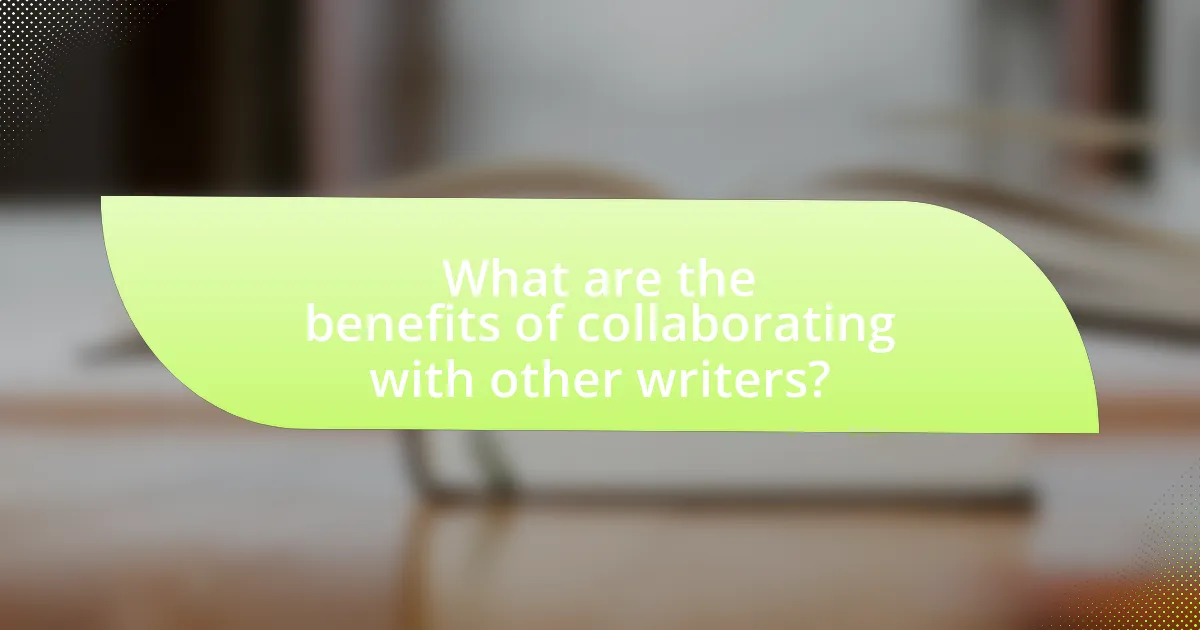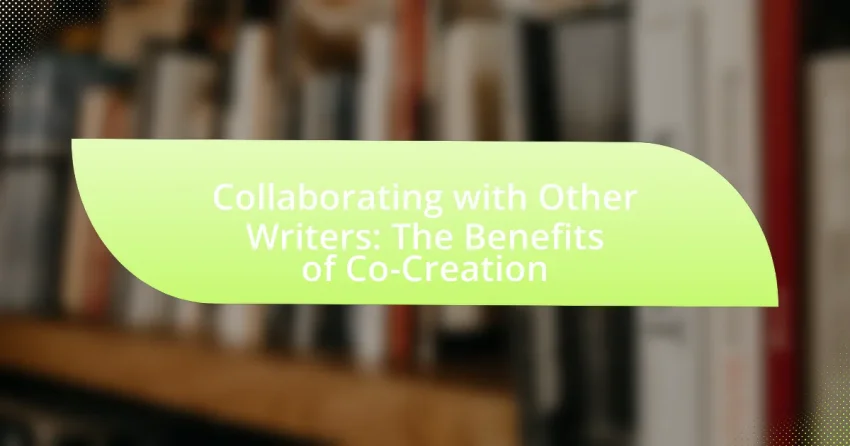Collaborating with other writers involves a partnership that enhances the writing process through shared ideas and diverse perspectives. This article explores how collaboration fosters creativity, improves productivity, and leads to higher-quality writing outcomes. Key elements of effective collaboration, such as clear communication and defined roles, are discussed alongside the influence of different writing styles on teamwork. Additionally, the article highlights the importance of co-creation in producing innovative content and examines the benefits and challenges of collaborative writing, including strategies for overcoming communication barriers and maintaining motivation.

What is Collaborating with Other Writers?
Collaborating with other writers involves working together to create content, share ideas, and enhance the writing process. This partnership can lead to diverse perspectives, improved creativity, and a more polished final product. Research indicates that collaboration can increase productivity and innovation, as seen in studies showing that co-authored papers often receive more citations than solo-authored works, highlighting the value of collective input in writing.
How does collaboration enhance the writing process?
Collaboration enhances the writing process by fostering diverse perspectives and ideas, which can lead to more innovative and comprehensive content. When multiple writers work together, they can share their unique insights and expertise, resulting in a richer narrative and improved problem-solving capabilities. Research indicates that collaborative writing can increase creativity and productivity; for instance, a study published in the Journal of Writing Research found that co-authoring can lead to higher quality outputs due to the pooling of knowledge and skills among writers. This synergy not only improves the final product but also encourages accountability and motivation among collaborators, further enhancing the writing experience.
What are the key elements of effective collaboration?
The key elements of effective collaboration include clear communication, mutual respect, defined roles, and shared goals. Clear communication ensures that all participants understand their tasks and expectations, which is essential for coordination. Mutual respect fosters a positive environment where diverse ideas can be shared and valued, enhancing creativity. Defined roles help to clarify responsibilities, preventing overlap and confusion among team members. Shared goals align the efforts of all collaborators, driving them toward a common objective. Research indicates that teams with these elements are more likely to achieve successful outcomes, as evidenced by studies showing that effective communication can improve team performance by up to 25%.
How do different writing styles influence collaboration?
Different writing styles significantly influence collaboration by affecting communication clarity, team dynamics, and the overall creative process. For instance, a writer with a concise style may streamline discussions, enabling quicker decision-making, while a more elaborate writer might encourage deeper exploration of ideas, fostering creativity. Research indicates that diverse writing styles can enhance collaborative outcomes by combining strengths; a study published in the Journal of Business Communication found that teams with varied communication styles produced more innovative solutions than homogeneous groups. Thus, the interplay of different writing styles can lead to more effective collaboration by balancing efficiency and creativity.
Why is co-creation important in writing?
Co-creation is important in writing because it enhances creativity and produces richer content. When writers collaborate, they combine diverse perspectives and skills, leading to innovative ideas and solutions that may not emerge in solitary writing. Research indicates that collaborative writing can improve the quality of the final product, as seen in studies where co-authored works often receive higher ratings for originality and depth compared to solo efforts. This collaborative process not only fosters a sense of community among writers but also allows for shared learning and growth, ultimately benefiting the writing itself.
What unique perspectives do co-writers bring to a project?
Co-writers bring diverse viewpoints and experiences to a project, enhancing creativity and depth. This diversity can lead to innovative ideas that a single writer might not conceive, as different backgrounds and writing styles contribute to a richer narrative. For instance, co-writers can challenge each other’s assumptions, leading to more nuanced characters and plots. Research indicates that collaboration often results in higher-quality outcomes, as seen in studies where teams outperform individuals in creative tasks due to the pooling of varied insights and skills.
How does co-creation foster creativity and innovation?
Co-creation fosters creativity and innovation by bringing together diverse perspectives and expertise, which enhances problem-solving and idea generation. When individuals collaborate, they combine their unique skills and experiences, leading to a richer pool of ideas. Research by the Harvard Business Review indicates that teams that engage in co-creation are 30% more likely to generate innovative solutions compared to those working in isolation. This collaborative environment encourages experimentation and risk-taking, further driving creative outcomes.

What are the benefits of collaborating with other writers?
Collaborating with other writers enhances creativity and broadens perspectives. When writers work together, they combine their unique ideas and styles, leading to innovative content that may not emerge in solitary writing. Research indicates that collaboration can improve writing quality; for instance, a study published in the Journal of Educational Psychology found that peer collaboration significantly boosts writing performance among students. Additionally, collaboration fosters accountability and motivation, as writers are more likely to stay committed to their projects when working with others. This synergy not only enriches the writing process but also expands professional networks, providing opportunities for future collaborations and exposure to diverse audiences.
How does collaboration improve the quality of writing?
Collaboration improves the quality of writing by integrating diverse perspectives and expertise, which enhances creativity and depth. When multiple writers contribute, they bring unique insights and skills that can elevate the overall narrative and structure. Research indicates that collaborative writing often results in higher-quality outcomes, as seen in studies where peer feedback significantly improved drafts, leading to clearer arguments and more engaging content. For instance, a study published in the Journal of Writing Research found that collaborative writing groups produced work with better coherence and organization compared to solo efforts. This evidence supports the notion that collaboration not only enriches the writing process but also leads to superior final products.
What role does feedback play in collaborative writing?
Feedback is essential in collaborative writing as it enhances the quality of the final product and fosters effective communication among writers. It allows team members to share diverse perspectives, identify strengths and weaknesses in the text, and refine ideas collectively. Research indicates that constructive feedback can lead to improved writing skills and greater satisfaction among collaborators, as it encourages a sense of ownership and accountability in the writing process. For instance, a study published in the Journal of Writing Research highlights that peer feedback significantly contributes to the development of writing proficiency and collaborative skills among participants.
How can diverse viewpoints enhance narrative depth?
Diverse viewpoints enhance narrative depth by introducing a variety of perspectives that enrich character development and plot complexity. When writers collaborate, they bring unique cultural backgrounds, experiences, and ideologies, which can lead to more nuanced storytelling. For instance, research by the National Endowment for the Arts indicates that diverse narratives can foster empathy and understanding among audiences, as they encounter characters and situations that reflect a broader spectrum of human experience. This multiplicity of viewpoints not only makes narratives more relatable but also challenges stereotypes, ultimately leading to a more engaging and thought-provoking story.
What are the potential challenges of co-writing?
The potential challenges of co-writing include differing creative visions, communication issues, and unequal workload distribution. Differing creative visions can lead to conflicts over the direction and style of the project, making it difficult to reach a consensus. Communication issues may arise from misunderstandings or lack of clarity, which can hinder collaboration and affect the quality of the work. Additionally, unequal workload distribution can create tension if one writer feels they are contributing more than the other, leading to frustration and resentment. These challenges can impact the overall success of the co-writing endeavor.
How can differing opinions be managed in a writing team?
Differing opinions in a writing team can be managed through structured communication and collaborative decision-making processes. Establishing regular meetings allows team members to express their viewpoints openly, fostering an environment of respect and understanding. Utilizing techniques such as brainstorming sessions can help integrate diverse ideas, while setting clear guidelines for constructive feedback ensures that discussions remain focused and productive. Research indicates that teams that engage in open dialogue and actively seek consensus are more likely to produce high-quality work, as they leverage the strengths of varied perspectives.
What strategies can be employed to overcome communication barriers?
To overcome communication barriers, employing strategies such as active listening, using clear and concise language, and fostering an inclusive environment is essential. Active listening ensures that all parties feel heard and understood, which can significantly reduce misunderstandings. Clear and concise language minimizes ambiguity, making it easier for collaborators to grasp ideas quickly. Additionally, fostering an inclusive environment encourages diverse perspectives, which can enhance creativity and problem-solving. Research indicates that effective communication practices lead to improved collaboration outcomes, as seen in studies highlighting the positive impact of clear communication on team performance.

How can writers effectively collaborate?
Writers can effectively collaborate by establishing clear communication, defining roles, and utilizing collaborative tools. Clear communication ensures that all writers are aligned on goals, deadlines, and expectations, which is crucial for maintaining a cohesive project. Defining roles helps each writer understand their responsibilities, reducing overlap and confusion. Utilizing collaborative tools, such as Google Docs or project management software, facilitates real-time editing and feedback, enhancing the writing process. Research indicates that teams that communicate effectively are 25% more productive, highlighting the importance of these strategies in successful collaboration.
What tools and platforms facilitate collaboration among writers?
Tools and platforms that facilitate collaboration among writers include Google Docs, Microsoft Word Online, and Slack. Google Docs allows multiple users to edit documents simultaneously, providing real-time feedback and comments, which enhances collaborative writing. Microsoft Word Online offers similar features, enabling writers to work together on documents from different locations while maintaining version control. Slack serves as a communication platform where writers can discuss ideas, share files, and coordinate tasks, streamlining the collaborative process. These tools are widely used in writing communities and organizations, demonstrating their effectiveness in fostering collaboration among writers.
How do online writing communities support co-creation?
Online writing communities support co-creation by providing platforms for collaboration, feedback, and shared resources among writers. These communities facilitate real-time interactions, allowing writers to brainstorm ideas, co-author works, and refine their writing through constructive criticism. For instance, platforms like Wattpad and Scribophile enable users to share their drafts and receive input from peers, enhancing the quality of the final product. Additionally, many online writing groups host collaborative projects, such as anthologies or writing challenges, which encourage participants to contribute their unique voices while working towards a common goal. This collaborative environment fosters creativity and innovation, making co-creation a central aspect of the writing process within these communities.
What are the best practices for using collaborative writing software?
The best practices for using collaborative writing software include establishing clear communication, defining roles and responsibilities, and utilizing version control features. Clear communication ensures that all team members are aligned on goals and expectations, which enhances productivity. Defining roles helps to streamline the writing process, allowing individuals to focus on their strengths, whether it be content creation, editing, or research. Utilizing version control features is crucial as it allows users to track changes, revert to previous versions, and maintain a coherent document history, thereby reducing the risk of errors and confusion. These practices are supported by studies indicating that effective collaboration tools can improve team efficiency by up to 30%.
What are some successful examples of co-created works?
Successful examples of co-created works include the “The Sandman” graphic novel series by Neil Gaiman and various artists, which showcases a collaborative effort in storytelling and illustration. Another notable example is the “Star Wars” franchise, where multiple writers and directors have contributed to the expansive universe, resulting in a rich tapestry of narratives. Additionally, the “Minecraft” game allows players to co-create content, leading to a vast array of user-generated worlds and experiences. These examples illustrate how collaboration can enhance creativity and produce impactful works across different mediums.
How have famous authors collaborated in the past?
Famous authors have collaborated in various ways, including co-writing novels, sharing ideas, and contributing to anthologies. For instance, the collaboration between William Faulkner and the playwright Tennessee Williams resulted in the play “The Seven Descents of Myrtle,” showcasing how two distinct literary voices can merge to create a unique work. Additionally, the Beat Generation authors, such as Jack Kerouac and Allen Ginsberg, often exchanged drafts and ideas, influencing each other’s writing styles and themes. These collaborations not only enriched their individual works but also contributed to the evolution of literary movements.
What lessons can be learned from successful co-writing projects?
Successful co-writing projects demonstrate the importance of clear communication and defined roles among collaborators. Effective communication ensures that all writers are aligned on the project’s vision, which enhances creativity and minimizes misunderstandings. For instance, a study by the University of Southern California found that teams with established communication protocols produced higher-quality work compared to those without. Additionally, defining roles allows each writer to leverage their strengths, leading to a more efficient writing process. Research from the Journal of Business Communication indicates that teams with clearly defined responsibilities are 30% more productive. These lessons highlight that successful co-writing hinges on structured collaboration and open dialogue.
What tips can enhance the collaborative writing experience?
To enhance the collaborative writing experience, establish clear communication among all participants. Effective communication ensures that everyone understands their roles, deadlines, and the overall vision of the project. Research indicates that teams with strong communication practices are 25% more productive, as highlighted in a study by the Project Management Institute. Additionally, utilizing collaborative tools like Google Docs or Trello can streamline the writing process, allowing real-time feedback and organization. These tools facilitate transparency and accountability, which are crucial for successful collaboration.
How can writers establish clear roles and responsibilities?
Writers can establish clear roles and responsibilities by creating a detailed project outline that specifies each writer’s tasks and contributions. This approach ensures that all participants understand their individual responsibilities, which enhances collaboration and minimizes overlap. For instance, assigning specific sections of a document to different writers can clarify who is accountable for each part, thereby streamlining the writing process. Additionally, regular communication and feedback sessions can reinforce these roles, allowing writers to address any ambiguities or conflicts in responsibilities as they arise.
What are effective ways to maintain motivation and accountability in a writing partnership?
Effective ways to maintain motivation and accountability in a writing partnership include setting clear goals, establishing regular check-ins, and providing constructive feedback. Clear goals ensure both partners understand the objectives and deadlines, which fosters a sense of purpose. Regular check-ins, whether weekly or bi-weekly, create a structured environment for discussing progress and challenges, reinforcing commitment. Constructive feedback encourages improvement and keeps both writers engaged in the collaborative process. Research indicates that accountability mechanisms, such as shared deadlines and mutual support, significantly enhance productivity in collaborative writing efforts.
